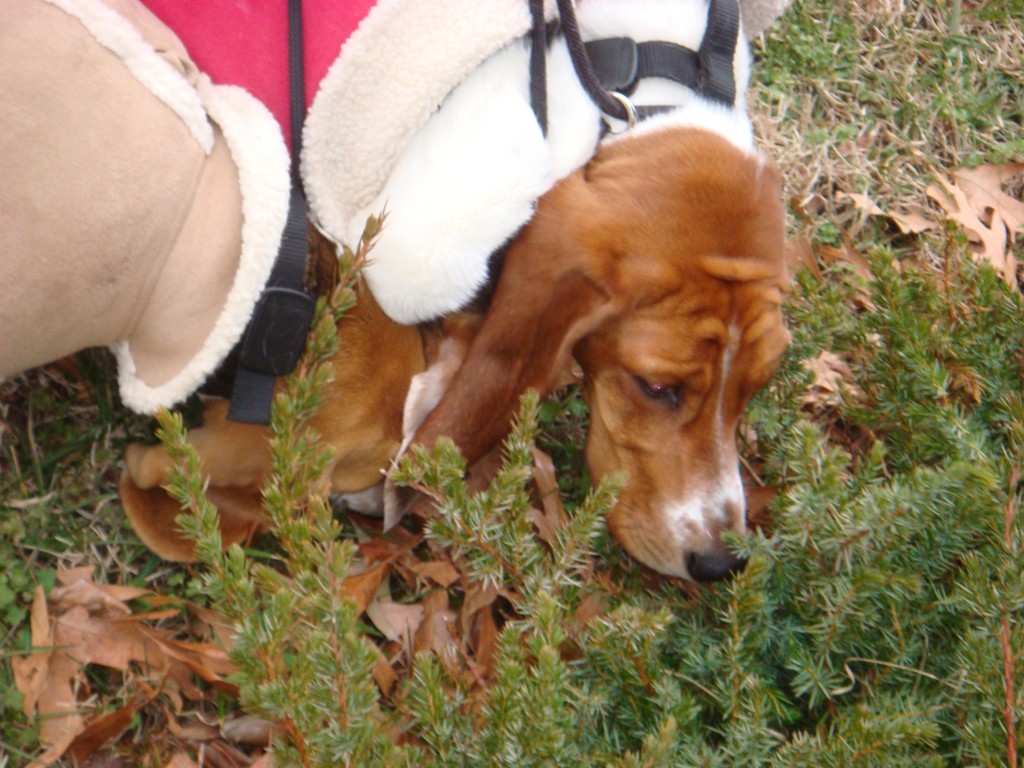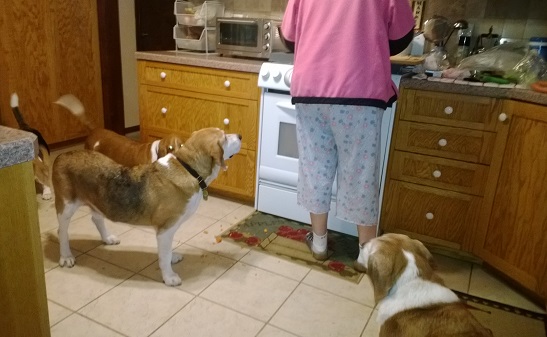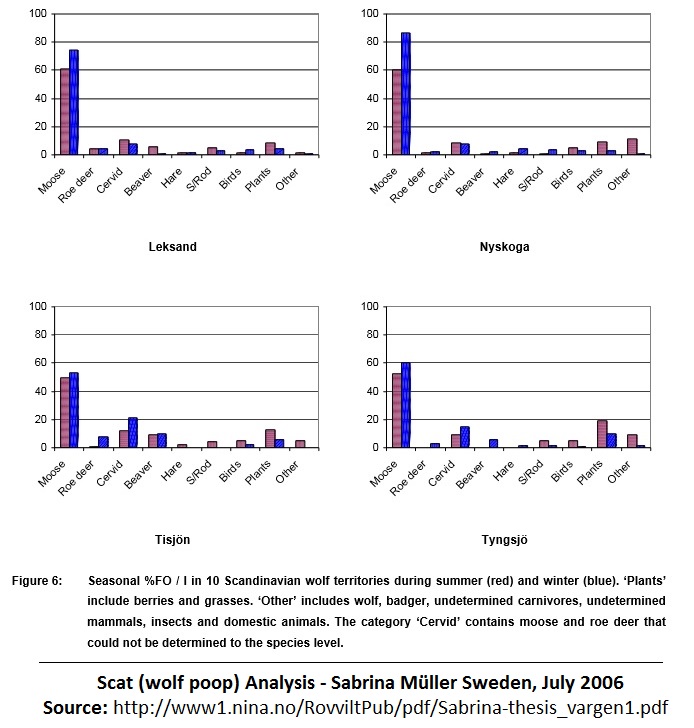My dog is a carnivore – Really? – Obligatory or Facultative?
Original article by S. Veigel 07/22/2015
Reviewed for relevancy June 25, 2020
 According to biology online at https://www.biology-online.org/dictionary/Omnivore a carnivore is an animal “that feed(s) (exclusively) on animals”. Herbivores “feed (exclusively) on plants” and the “Omnivore” is “An animal that includes both plants and animals in its normal diet”.
According to biology online at https://www.biology-online.org/dictionary/Omnivore a carnivore is an animal “that feed(s) (exclusively) on animals”. Herbivores “feed (exclusively) on plants” and the “Omnivore” is “An animal that includes both plants and animals in its normal diet”.
Most everything we read refers to the wolf/dog as a “carnivore”. And so we are all obliged to use the classification of “carnivore” when discussing wolves/dogs. When I look at my dogs’ teeth I see “carnivore” plain and simple. I understand they don’t have Amylase in their saliva (though they do produce it in the pancreas) to predigest starch/carbohydrates and when I see them eating meat, I think “carnivore”. End of story. But that requires us to ignore everything else we see. Somewhere in the back of our mind we’re thinking, “Well, they’re carnivores so pay no attention to how they enjoy vegetation, fungus and fruits. All carnivores do that, right?”
Maybe there’s a qualifier to the “carnivore” definition somewhere. Maybe the word “exclusively” is a typo. Or maybe the wolf/dog isn’t smart enough to know what it should eat. Because I read and hear “carnivore” but by strict definition I observe “omnivore”. That can’t be right. I read and hear “vicious predator” but I see Platypus.
You know what I mean. The Platypus. That fur covered animal with a ducks’ bill and webbed feet. It’s a mammal but it lays eggs. In contrast we have the wolf/dog. It is not a scavenger but it will scavenge. Instead of talons or hooked claws to hang onto prey it has claws that are only good for scratching an itch and digging (maybe a little traction in a run). It has teeth like a vicious predator but it’s at a disadvantage because it can only catch prey with its mouth. In a run that limitation can throw it off balance or break its stride while trying to take down an animal. So it relies on a group or “pack” in an attempt to out maneuver and overwhelm large prey by sheer numbers. A lone wolf has a harder time.
I’m crazy, right? Ah, but read on. Apparently there is more to the “carnivore” definition.
I: Which type of carnivore is your dog?
The best description I’ve read about wolves is that they are “omnivorous opportunistic carnivores”. And the dog is a great example as a descendant of the wolf.
 So I’m sitting in the family room with a plate of steak – a rare treat – watching television. The dogs are just lying around and giving me plenty of space. No one is anxiously eying my plate or begging. Suddenly there’s a tap coming from the kitchen and all 4 dogs go running in. After a while I enter the kitchen to find them all crowding a corner where my wife is slicing a cucumber. Every so often she hands them a slice and they’re snapping for it as if it were the most delicious dog cookies you could find.
So I’m sitting in the family room with a plate of steak – a rare treat – watching television. The dogs are just lying around and giving me plenty of space. No one is anxiously eying my plate or begging. Suddenly there’s a tap coming from the kitchen and all 4 dogs go running in. After a while I enter the kitchen to find them all crowding a corner where my wife is slicing a cucumber. Every so often she hands them a slice and they’re snapping for it as if it were the most delicious dog cookies you could find.
Another day I was eating an apple. I laid it on the end table where I was sitting for a moment and Smoke quickly rose to his feet and snatched it – something he never did before. The next time I went to get an apple Smoke jumped for it trying to take it from me.
Kitcheree, cucumber, green beans, rice, apples, grass, roots, poop, fungus, cauliflower. My granddaughter dropped some berries on the floor and I just stood there and watched Smoke investigate. He sniffed, then licked, thought about it, then sniffed and licked again. Then he ate it. You could see he thought it was a little tart. But he liked it.

I was perplexed. Wolves have been observed eating roots, earth worms, fungus, berries, bugs, lizards garbage and poop. Every dog I ever had ate such things. Millie (our Basset) went after a June bug as if it were a squirrel and wouldn’t give up until she ate it. Back in the 1980’s Flash use to love chewing on a broccoli stalk. Smoke loves cauliflower, but broccoli’s too weird. After feeding my dogs a quality meat-based protein diet they often go out, nibble grass, dig for tree roots and try to eat some poop before I catch them (yes, any dog will eat poop). So how does this fit a “carnivore” classification?
Getting more perplexed and not seeing strict “carnivore” behavior I was reading one article where the author was pushing the concept that wolves/dogs can’t digest vegetable matter and fruit because they don’t have Amylase in their saliva. In evidence the author presented the fact that berries have been found in wolf dung proving it’s not digestible. But then, doesn’t that also give credibility to the fact that they do eat them? There are hard berries, young berries and ripe berries. In the wild wolves do get parasites and/or otherwise have a bad digestion day. It’s not their primary diet, but apparently, in the wild, without human intervention or conditioning wolves do choose to eat berries. Why do carnivores eat berries?
Then I found it.
Apparently I’m not the only one who noticed that wolves/dogs tend to skirt the boundaries, dodging in and out between “carnivore” and “omnivore”. Many people were divided. By strict definition the wolf/dog was an omnivore but others insisted the teeth and not having Amylase in the saliva was problematic. To solve this the carnivore classification was divided into subcategories. One subcategory was the “Obligatory Carnivore” and the other was the “Facultative Carnivore”.
We always hear and read “carnivore” when it comes to wolves/dogs because it’s easier to just say “carnivore” than it is to explain “Facultative” every time you mention it. And you can say, “Carnivore” because by dividing it into subcategories you are still referring to “carnivores” in general. But when you feed your “carnivore” it helps to understand the difference.
The “Obligatory Carnivore” is like the lion. It is built to catch and is obliged to “exclusively” feed on other animals. The “Facultative Carnivore” is the wolf/dog. Where the word “Facultative” means “Optional/Discretionary”. A bit weird, it’s almost the same as an omnivore, but omnivores have flat molars. Wolves/dogs have edged molars. So I guess nature intended it to mostly be a carnivore.
II: Natures’ intention is never simple – Teeth don’t cut it
The phrase I enjoy is “nature intended”. It’s ok as a euphemism, but never really works as a fact. “Nature intended wolves and dogs to only eat meat, to be carnivores, because it gave them a jaw that only moves up and down, sharp edged molars and they don’t produce Amylase in their saliva”. Ergo, only feed your dog meat because “nature intended”.
What did nature intend? There’s actually a riddle in the teeth. “What has teeth and a jaw like a cow, eats vegetation and is a formidable carnivorous predator?” Answer, “Humans”. Then there’s the omnivore the Black Bear. It has long fangs (canine teeth), jaw movement like a carnivore, ripping claws and flat molars. “What has sharp edged molars, fangs (canine teeth), claws for digging, hunts animals and eats vegetation”? Answer, “The wolf/dog”.
Ah, but the Amylase. Don’t forget the Amylase.
An article on the Innovative Veterinary Care (IVC Journal) website titled “Digestive Enzymes” by Jean Hofve, DVM at http://ivcjournal.com/digestive-enzymes/ informs us that there are three categories of digestive enzymes. “Protease to break down protein, Lipase to digest fat and Amylase to process carbohydrates”. She also points out that “Most mammals produce Amylase in their saliva, but dogs and cats do not”.
I recommend you read this article. She includes some information about how cells break down and how a fresh kill may not be that easy to digest.
In this article Dr. Hofve is making a case for supplementation by describing how heat processing pet food can destroy the natural shape of enzymes. She recommends the use of digestive enzymes and points out that, “the best enzymes come from plants or fungi (yeast), because they can survive the trip through the stomach’s acidic environment”. I might add it’s a bit like wolves eating fungi and plant material, isn’t it? Your dog nibbling in the yard?
Don’t get me wrong. I would never suggest that you feed your dog a lot of starch/carbohydrates any more than I’d recommend a bag of potato chips for breakfast. But even though the wolf/dog does not produce Amylase in the saliva, though we are relatively better at predigesting starch/carbohydrates in our mouth, the wolf/dogs’ pancreas does produce enough Amylase, Lipase and Protease that it injects into the intestinal tract. That is the primary function of the pancreas in all of us. And the chlorophyll in green vegetation is good for the pancreas. Grass has a peptic quality as well. So nature provided and the wolf/dog benefits (“everything in moderation”). Which may be why “nature intended” them to eat some.